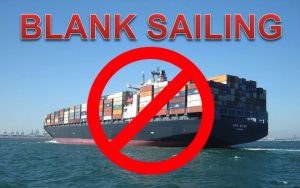What is Blank Sailing?

Blank Sailing
If you’re a shipper and you’ve heard the words “blank sailing,” there’s a decent chance they were accompanied by frustration. That’s because blank sailing often means delay and can also mean increased cost for shippers.
Blank sailing is a term that basically means no sailing or, perhaps more precisely, canceled sailing.
In order to reduce capacity and increase freight rates, organized groups of carriers or shipping lines in the international shipping industry create blank sailings by omitting sailings that were previously scheduled.
A blank sailing could refer to a sailing skipping one specific port (while still traversing the rest of the scheduled route) or the entire sailing being canceled.
There are reasons other than carriers reducing capacity in attempt to stabilize or increase freight rates for blank sailings. A port may be experiencing severe congestion or delays due to labor strife, weather, or other factors that could cause a carrier to skip that port in order to keep the rest of the sailing on schedule. A ship could need repairs, preventing it from fulfilling its originally scheduled sailing. A carrier could pull a ship from a route for a “more urgent” sailing.
(For definitions of more shipping terms, check out the Logistics Glossary on our Resources Page.)
Despite the array of possibilities that could cause blank sailings, carriers doing it to reduce capacity in order to affect freight rates is the most common.
Now, with all the carrier alliances dominating the industry, it is perhaps easier for carriers to work together to create blank sailings than ever before. This counters the selling point carriers make for their alliances that they will make sailing schedules more reliable.
With carriers struggling against overcapacity in the international shipping industry over the last several years, blank sailings are common and likely to become even more so.
When a shipper has the misfortune of having cargo scheduled on a blank sailing, he or she must wait for the next available sailing before that cargo gets loaded and moved. Often this delay is a week, but it has also happened that such delays have taken a month or more.
Currently, 2M and CKYE carriers are implementing blank sailings in the transpacific trade route. November just say blank sailing from CKYE’s NUE/Vespucci service from Asia to the United State’s East Coast and 2M’s Maple service from Asia to the United State’s West Coast. December will kick off with another blank sailing from 2M’s Maple service.
Here are the specifics on the blank sailings the carriers provided:
| Week # | Trade Lane | Lanes | Alliance | Service | Vessel Provider | Slot Buyers | Rotation | Year | Starting Port | ETD | Vessel Size |
| 47 | Asia – USEC | TP | CKYE | NUE / Vespucci | Evergreen / COSCO / K Line / Yang Ming | UASC / CMA CGM | Qingdao, Ningbo, Shanghai …(Pan)… Colon-Coco Solo (~Cristobal), Savannah, Charleston, Baltimore, New York, Colon-Coco Solo (~Cristobal) …(Pan)… Qingdao | 2016 | CNTAO | 22-Nov-16 | 8,577 |
| 46 | Asia – USWC | TP | 2M | Maple | MSC | Maersk | Yantian, Shanghai, Busan, Long Beach, Vancouver, Yantian | 2016 | CNYTN | 18-Nov-16 | 6,966 |
| 48 | Asia – USWC | TP | 2M | Maple | MSC | Maersk | Yantian, Shanghai, Busan, Long Beach, Vancouver, Yantian | 2016 | CNYTN | 1-Dec-16 | 6,966 |
The specific dates of those week numbers are as follow:
- Week 46 – November 14th-20th
- Week 47 – November 21st-27th
- Week 48 – November 28th-December 4th




